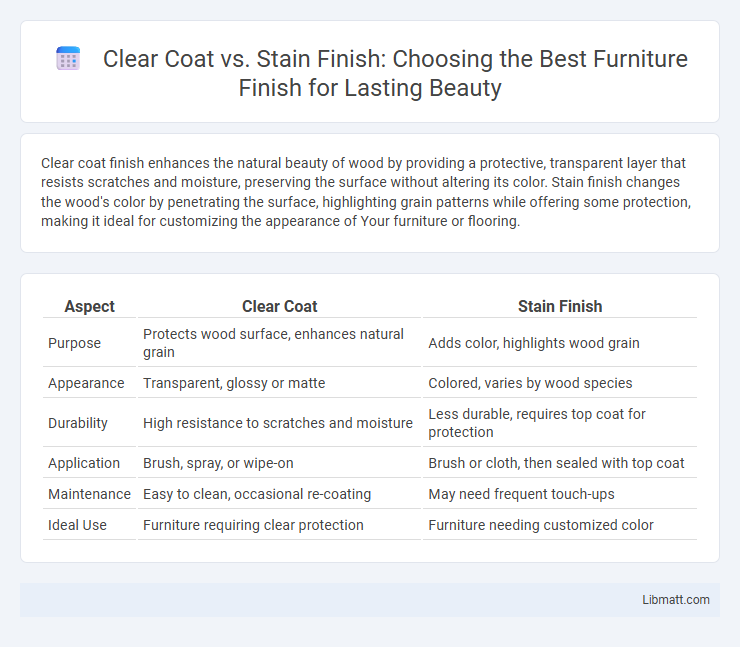Clear coat finish enhances the natural beauty of wood by providing a protective, transparent layer that resists scratches and moisture, preserving the surface without altering its color. Stain finish changes the wood's color by penetrating the surface, highlighting grain patterns while offering some protection, making it ideal for customizing the appearance of Your furniture or flooring.
Table of Comparison
| Aspect | Clear Coat | Stain Finish |
|---|---|---|
| Purpose | Protects wood surface, enhances natural grain | Adds color, highlights wood grain |
| Appearance | Transparent, glossy or matte | Colored, varies by wood species |
| Durability | High resistance to scratches and moisture | Less durable, requires top coat for protection |
| Application | Brush, spray, or wipe-on | Brush or cloth, then sealed with top coat |
| Maintenance | Easy to clean, occasional re-coating | May need frequent touch-ups |
| Ideal Use | Furniture requiring clear protection | Furniture needing customized color |
Introduction to Clear Coat and Stain Finish
Clear coat finish provides a transparent protective layer that enhances the durability and gloss of wood surfaces while preserving the natural grain. Stain finish penetrates the wood fibers to alter color, highlighting texture and adding depth without forming a surface film. Choosing between these finishes depends on the desired aesthetic and level of protection required for wood projects.
What is a Clear Coat Finish?
A clear coat finish is a transparent protective layer applied over wood or painted surfaces to enhance durability and resistance to moisture, UV rays, and scratches. It preserves the natural appearance or underlying stain while providing a smooth, glossy, or matte sheen depending on the product used. You can improve the longevity and aesthetic appeal of your wood projects by choosing a high-quality clear coat finish.
Understanding Stain Finishes
Stain finishes penetrate wood fibers to enhance natural grain patterns while adding color, offering protection without obscuring texture. Unlike clear coats that create a surface barrier, stains allow your wood to maintain breathability and emphasize its organic beauty. Choosing between stain and clear coat depends on whether you prefer color enhancement or surface protection for your project.
Key Differences Between Clear Coat and Stain
Clear coat provides a protective, transparent layer that enhances durability and preserves the wood's natural appearance, while stain soaks into the wood to change its color and accentuate grain patterns. Clear coats offer superior resistance to moisture, UV rays, and scratches, making them ideal for surfaces requiring long-term protection. You should choose stain if your goal is to alter the wood's tone without adding surface protection, whereas clear coat is best for maintaining both aesthetics and structural integrity.
Aesthetic Impact: Clarity vs. Color
Clear coat enhances the natural beauty of wood by preserving its original clarity and grain patterns, providing a glossy or satin protective layer without altering the color. Stain finish deeply penetrates the wood fibers, adding rich color tones that can range from light tints to dark hues, transforming the wood's appearance while allowing its texture to remain visible. Choosing between clear coat and stain finish ultimately depends on whether you prefer to showcase the wood's natural look or introduce a customized color palette.
Durability and Protection Comparison
Clear coat finishes offer superior durability by forming a hard, transparent barrier that protects wood surfaces from scratches, moisture, and UV damage, extending the lifespan of furniture and flooring. Stain finishes penetrate the wood to enhance color and grain without providing significant surface protection, making them more susceptible to wear and environmental damage over time. For areas requiring long-lasting protection and resistance to physical damage, clear coat finishes are the preferred choice due to their robust sealing properties.
Application Process: Clear Coat vs. Stain
Clear coat application involves applying multiple layers of transparent varnish or polyurethane to protect and enhance the wood's natural appearance, requiring sanding between coats for a smooth finish. Stain finish, on the other hand, penetrates the wood surface to alter its color while enhancing the grain, typically needing a single application followed by a protective topcoat. Your choice between clear coat and stain depends on whether you want to emphasize the wood's texture or transform its color before sealing.
Maintenance and Longevity
Clear coat finishes provide a durable, protective layer that resists scratches, moisture, and UV damage, making maintenance simple with occasional cleaning and polishing. Stain finishes, while enhancing wood's natural grain and color, offer less protection and may require more frequent reapplication to maintain appearance and prevent damage. Your choice between clear coat and stain finish impacts the longevity and effort needed to preserve the wood's beauty over time.
Best Uses for Clear Coat Finishes
Clear coat finishes are ideal for protecting wood surfaces that require a durable, glossy appearance, such as furniture, cabinetry, and flooring. These finishes enhance the natural grain while providing resistance to scratches, water, and UV damage, making them suitable for both indoor and outdoor applications. Clear coats are especially beneficial for high-traffic areas where maintaining an attractive, long-lasting surface is essential.
Ideal Applications for Stain Finishes
Stain finishes are ideal for highlighting the natural grain and texture of wood in applications like furniture, cabinetry, and hardwood flooring, where enhancing the wood's character is desired. They penetrate the wood surface to provide color while allowing the natural patterns to show through, making them perfect for rustic or traditional designs. You'll find stain finishes especially effective in projects requiring color customization without the glossy or protective layer that a clear coat provides.
Clear Coat vs Stain Finish Infographic

 libmatt.com
libmatt.com